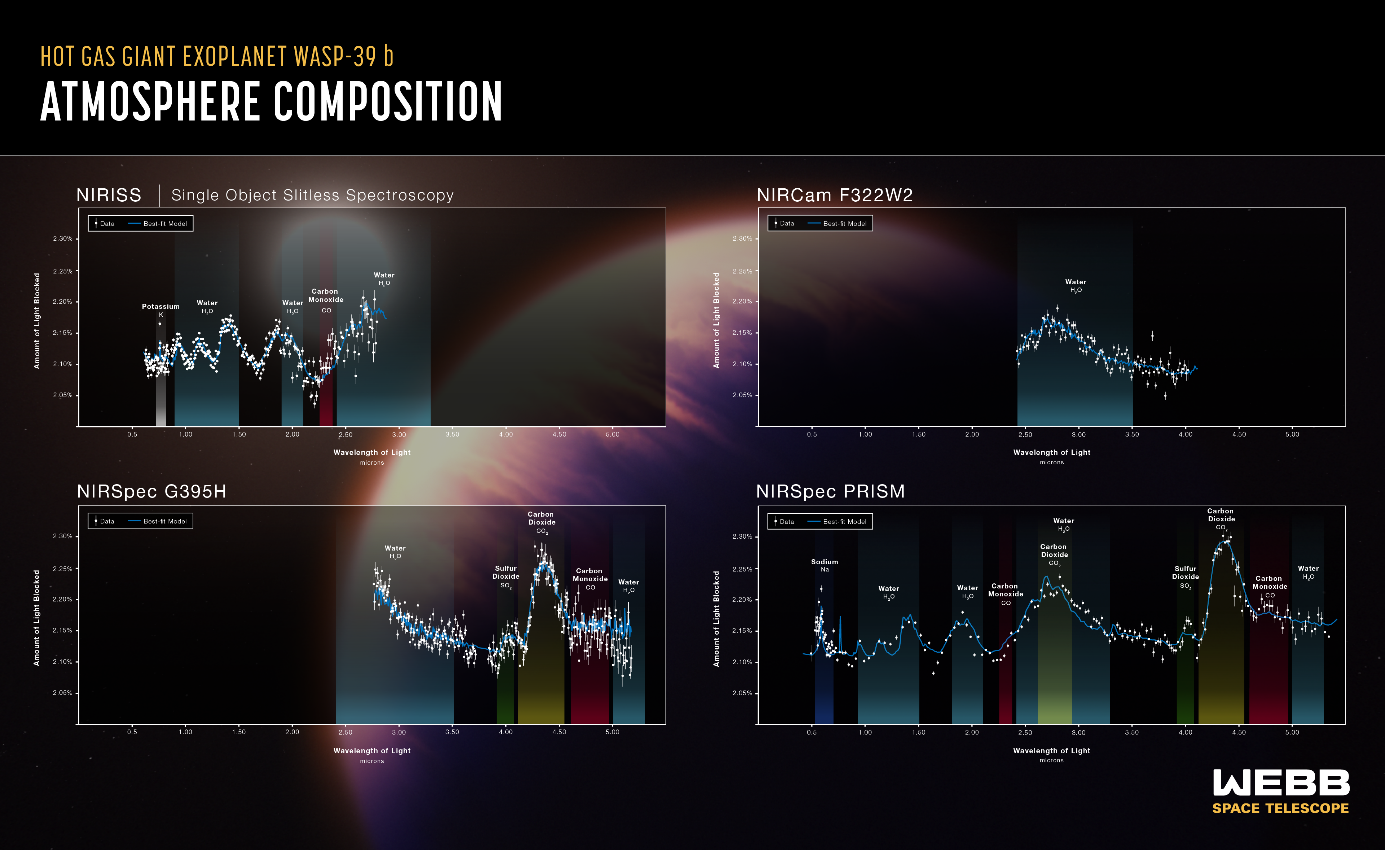First results from the James Webb Space Telescope: study of the atmosphere of the exoplanet WASP-39b
After a first paper published this summer, JWST reveals new results through 5 papers. The first data were processed by an international consortium (more than 300 scientists) to which several French laboratories belong, including LISA through Olivia Venot, CR. Her contribution to this study focused on the interpretation of the data using atmospheric composition models. More precisely, the chemistry models that she has realized have allowed, with others, to understand the formation of sulfur dioxide in the atmosphere of the exoplanet WASP-39B by photochemistry (Tsai, S.-M et al, 2022).
Reminder: What is the JWST ?
The James Webb Space Telescope (JWST) was developed by the U.S. space agency, with the help of the Canadian and European agencies, and launched in December 2021. This telescope makes observations mainly in the infrared. The spectral band covered allows better observations in this area than its predecessor the Hubble telescope. The scientific objectives are the search for the first stars and galaxies formed just after the Big Bang, the study of the formation of galaxies, stars and planets as well as their evolution, and the understanding of the appearance of life in planetary systems. For this purpose, four instruments have been installed on board the telescope: NIRCam, a wide-field infrared camera; NIRSpec, a spectrometer operating in the near infrared; MIRI, which combines a spectrometer operating in the mid-infrared and a camera; and NIRISS, a spectro-imager. The first images revealed recently have impressed by the quality of their details.
First results
By observing the light transmitted through the atmosphere of exoplanets during their transit, researchers can determine the composition of the atmosphere. One of the exoplanets observed during these first months is WASP-39B. This planet is a gas giant (of the hot Saturn type) located 700 light-years away. Thanks to the first results, the scientific team was able to detect not only water, carbon monoxide, sodium and potassium but also carbon dioxide and sulfur dioxide (Figure 1). The formation of sulfur dioxide is believed to be the result of photochemical reactions in the exoplanet's atmosphere, as demonstrated by both observations and atmospheric models. Indeed, under the action of UV, the water molecules will produce H and OH radicals by photolysis. These radicals will then allow the release of SH radicals and sulfur from H2S (hydrogen sulfide) present in the atmosphere. An oxidation in SO at first, then SO2 can then occur. It is the first time that such a process is observed for an exoplanet and surely the beginning of many discoveries on the formation and the understanding of these planets.

Figure 1. The atmospheric composition of the hot gas giant exoplanet WASP-39 b has been revealed by JWST. This plot shows four transmission spectra from three of the JWST instruments, operated in four instrumentation modes. At the top left, the NIRISS data show the fingerprints of potassium (K), water (H2O), and carbon monoxide (CO). Top right, NIRCam data show a significant water signature. Bottom left, NIRSpec data shows water, sulfur dioxide (SO2), carbon dioxide (CO2), and carbon monoxide (CO). At the bottom right, additional NIRSpec data reveal all of these molecules as well as sodium (Na). ILLUSTRATION: NASA, ESA, CSA, Joseph Olmsted (STScI)
More infos :
Article dans Nature
Articles
Rustamkulov, Z., Sing, D.K., Mukherjee, S. et al. Early Release Science of the exoplanet WASP-39b with JWST NIRSpec PRISM. Nature 614, 659–663 (2023).
Alderson, L., Wakeford, H.R., Alam, M.K. et al. Early Release Science of the exoplanet WASP-39b with JWST NIRSpec G395H. Nature 614, 664–669 (2023).
Ahrer, EM., Stevenson, K.B., Mansfield, M. et al. Early Release Science of the exoplanet WASP-39b with JWST NIRCam. Nature 614, 653–658 (2023)
Tsai, SM., Lee, E.K.H., Powell, D. et al. Photochemically produced SO2 in the atmosphere of WASP-39b. Nature (2023). https://doi-org.insu.bib.cnrs.fr/10.1038/s41586-023-05902-2
Feinstein, A.D., Radica, M., Welbanks, L. et al. Early Release Science of the exoplanet WASP-39b with JWST NIRISS. Nature 614, 670–675 (2023).

